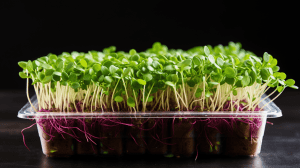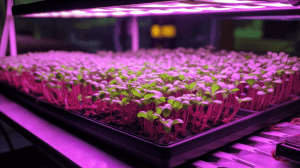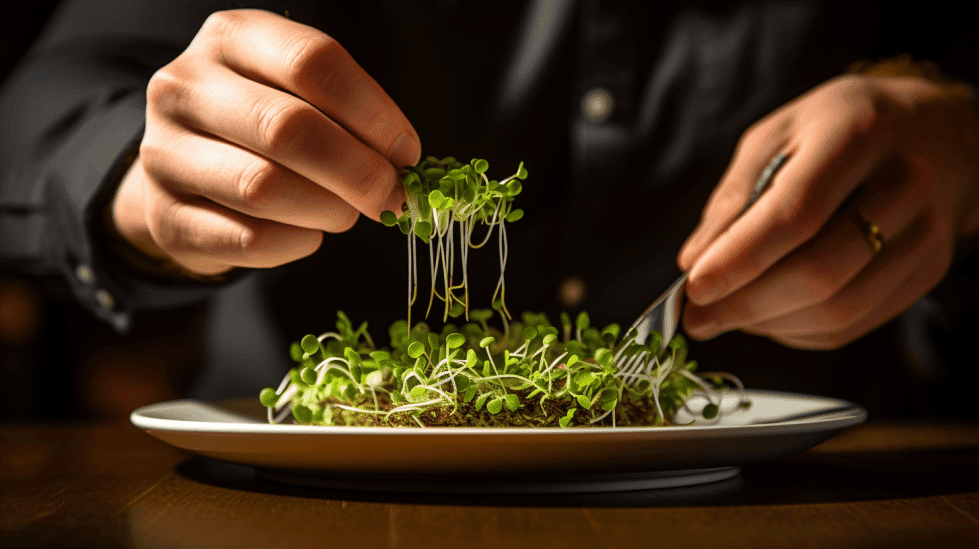How Much Microgreens to Eat Per Day
Microgreens have gained popularity in recent years for their nutritional benefits and versatility in various dishes. These tiny greens fall between a sprout and a baby green, offering a concentrated source of vitamins, minerals, and other beneficial nutrients. With so many people incorporating microgreens into their daily diets, an essential question arises: how much microgreens should you eat per day?
The answer to this question is subjective, as it depends on your personal dietary needs and what other foods you include in your meals. Generally, a serving size of microgreens is around 25 grams, or a little more than 3/4 of an ounce according to some websites. It’s always a good idea to consult with a nutritionist or healthcare professional to determine the right microgreens serving size for you.
Key Takeaways
- Microgreens offer a concentrated source of nutrients and vitamins in small servings
- The ideal daily serving size of microgreens varies based on individual dietary needs
- Consult a nutritionist or healthcare professional for personalized recommendations on incorporating microgreens into your diet
Understanding Microgreens
Microgreens, also known as tiny greens or micro herbs, are young vegetable greens that represent the early stages of a plant’s growth, typically including the plant’s first true leaves. These small greens offer intense flavors and are packed with a concentrated nutrient content, making them a popular addition to many dishes.
One aspect I often consider when discussing microgreens is the variety of types available. This can range from leafy greens like kale and spinach to more robust plants such as radish and beet. Each type of microgreen brings its unique flavor profile and nutritional composition, offering a wide range of options for incorporating these nutritious greens into my diet.
As someone who is interested in nutrition, I find it vital to emphasize the importance of determining how much microgreens should be eaten per day. According to various sources, a serving size of microgreens is around 25 grams, which is slightly more than 3/4 of an ounce. However, the specific amount of microgreens to consume daily depends on an individual’s overall diet and nutritional needs.
Personally, I like to incorporate microgreens into my meals as a way to boost the nutritional content of the dishes. Some of my favorite ways to include them are:
- As a garnish: Sprinkling microgreens on top of soups, salads, or other dishes adds both visual appeal and a burst of flavor.
- In smoothies: Blending microgreens with fruits and vegetables creates a nutrient-rich beverage.
- As a salad base: Mixing different types of microgreens together creates a delightful and diverse salad.
In conclusion, microgreens are an excellent addition to any meal. Not only do they provide a delicious crunch and flavor boost, but they’re also packed with nutrients. The recommended serving size for most types of microgreens is one or two ounces per person; however, this can vary depending on the type of green you use.
Nutritional Value of Microgreens

Microgreens are nutrient-dense foods that offer a rich source of essential nutrients, vitamins, and antioxidants. In this section, I’ll highlight the nutritional benefits of some popular microgreens, including broccoli, red cabbage, radish, and kale.
Broccoli Microgreens
When it comes to essential nutrients, my ideal choice is broccoli microgreens. They are an excellent source of vitamin K, vitamin E, and provide high levels of antioxidants. These essential vitamins play a key role in supporting various bodily functions, and the antioxidants help protect my body from the damaging effects of free radicals.
Red Cabbage Microgreens
For a colorful and nutritious addition to my diet, I opt for red cabbage microgreens. These vibrant greens are loaded with different vitamins, including a generous amount of vitamin C. Although they are low in vitamin E, their high nutrient content makes them a valuable option.
Radish Microgreens
Radish microgreens are another perfect choice for enhancing my vitamin and nutrient intake. Green daikon radish microgreens, for instance, are abundant in antioxidants, which contribute to my overall health by reducing oxidative stress in the body. Their bold and spicy flavor is an added bonus.
Kale Microgreens
Kale microgreens are a powerhouse of nutrients, offering a diverse range of essential vitamins. Their nutrient content is similar to that of mature kale, but in a more concentrated form. These tiny greens provide me with nutrients like vitamins K, C, and A, making them an excellent addition to my meals.
Incorporating these nutrient-dense microgreens into my daily diet helps me improve my overall health and well-being. Each variety has its unique set of nutrients, providing me with a wide array of essential vitamins and antioxidants to support my body’s functions.
Health Benefits of Microgreens

Microgreens have been gaining popularity in recent years because of their high nutritional value and potential health benefits. As an enthusiast of healthy eating, I find microgreens to be an excellent addition to my diet. They are rich in vitamins, minerals, and antioxidants, which can help protect our body from free radicals and improve overall health.
One of the most notable health benefits of microgreens is their potential role in reducing the risk of heart disease. These small plants contain a good amount of essential nutrients that can support cardiovascular health. For example, microgreens are rich in vitamin K, which helps maintain a healthy blood circulation and prevent blood clotting.
In addition to heart health, microgreens can also contribute to a healthy immune system. They are packed with essential nutrients like vitamins C, E, and K, as well as various minerals that are required for proper immune function. Consuming microgreens as a part of a balanced diet can help our body fight off infections and reduce the risk of chronic diseases.
Microgreens also possess anti-inflammatory properties that may play a role in supporting cognitive function. Studies have shown that consuming foods with anti-inflammatory properties could help protect our brain from degenerative diseases and promote mental clarity.
Eating microgreens is not only beneficial for our physical health but also contributes to a healthy diet and improves overall well-being. Their low-calorie content and high nutritional value make them a perfect addition to various dishes, such as salads, sandwiches, or smoothies. Including them in your daily meals can bring variety to your diet and help you maintain good health.
So, to enjoy the health benefits of microgreens, it’s recommended to consume about 1-2 ounces or two cups of raw microgreens daily. Keep in mind that they shouldn’t be the sole source of nutrients in your diet, but rather a supplement for a balanced and diverse diet.
Incorporating Microgreens Into Diet
Incorporating microgreens into my daily diet has been a great way to boost the nutritional value of my meals without adding too many calories. A small amount of microgreens can make a big difference in enhancing the flavor and visual appeal of a variety of dishes.
By including a variety of microgreens in my meals, I give myself the opportunity to enjoy a diverse range of flavors, textures, and health benefits. Microgreens can be easily added to salads, smoothies, sandwiches, or even as a garnish for soups and main dishes. Their vibrant colors and unique tastes can turn even the simplest dish into a nutrient-packed and visually stunning meal.
With the help of a step-by-step guide, I found it quite easy to grow my microgreens at home, allowing me to always have fresh, organic produce readily available. This has not only helped me cut down on grocery costs but has also made me more inclined to include microgreens in my recipes, as they are always within reach.
Including microgreens in my daily diet has proven to be a nutritious addition that works well with my goal of maintaining a healthy diet. The ease of growing and incorporating a variety of microgreens into a variety of dishes makes them a great addition to anyone striving to enhance their overall health and well-being.
Microgreens Serving Size
When it comes to microgreens, knowing the proper serving size can be important for ensuring you receive all of their nutritional benefits without overindulging. As a general guideline, a serving size of microgreens is around 25 grams, which is slightly more than 3/4 of an ounce. This is because these little greens are nutritionally dense compared to their mature counterparts.
In relation to the daily recommended dietary allowance, consuming 1-2 ounces of microgreens per day can provide a good source of vitamins, minerals, and antioxidants, like vitamin C. In fact, some small-sized microgreens contain much more vitamin C than baby greens, making them an excellent choice for those looking to reach their daily vitamin intake.
However, it’s important not to rely solely on microgreens for all of your nutritional needs. Their serving sizes should be balanced with a variety of other healthy foods to ensure a well-rounded diet. For optimal health, it is recommended to consume around 1-2 cups of microgreens per day. This can be divided into separate meals or snacks throughout the day, making it simple to incorporate them into your meals.
When it comes to determining the right amount of microgreens to eat, it’s important to consider the specific type and how they’ll be used in a dish. A single serving of microgreens can typically be a small handful or a few pinches, which can be added to salads, sandwiches, and other dishes for extra flavor and nutrition. This allows for flexibility in the number of servings of microgreens consumed per day.
As a final note, it’s important to consult a healthcare professional or nutritionist to determine the best serving size for your specific needs. Large quantities of microgreens might not be suitable for everyone, so it’s crucial to find the right balance for your individual dietary requirements.
Comparison Between Mature Greens and Microgreens
When it comes to incorporating greens into our daily diet, both mature greens and microgreens offer a plethora of health benefits. I would like to highlight the key differences and similarities between these two types of greens.
Firstly, mature greens are the fully-grown counterparts of plants, such as spinach, kale, and lettuce. They have been grown to their full size and usually have fully developed leaves, stalks, and sometimes flowers. As for microgreens, they are the early-stage versions of these plants, harvested when they are only around 10-25 days old. Despite their small size, microgreens are packed with nutrients and flavors.
In terms of nutritional content, both mature greens and microgreens offer an array of vitamins, minerals, and other beneficial compounds. Microgreens, however, have been found to have a higher concentration of nutrients per gram, meaning that even small amounts can contribute significantly to our daily requirements. For instance, a study found that microgreens can contain up to 40 times more nutrients than their mature counterparts.
Although microgreens are denser in nutrients, mature greens should not be disregarded. Mature vegetables offer a variety of textures and flavors that can be more versatile in the kitchen, and they are an essential component of a balanced diet. Additionally, mature greens often have a longer shelf life compared to microgreens, making them a more practical option for use in meal planning and storage.
Both microgreens and mature plants have their advantages, and I believe that incorporating a mix of the two can provide the best of both worlds when it comes to nutrition and variety. Microgreens can add a burst of flavor and concentrated nutrients to dishes, while mature greens can provide bulk and versatility, making it easy to meet the recommended daily intake of fruits and vegetables.
In summary, while microgreens may be denser in nutrients than their mature counterparts, it’s important to include both types of greens in a healthy, diverse diet. Whether you choose to consume them in salads, smoothies, or cooked dishes, both mature vegetables and microgreens can offer a wide range of benefits for overall health and well-being.
Hygiene and Safety Concerns
I cannot stress enough the importance of maintaining proper hygiene and safety measures when consuming microgreens. Like any other raw food products, microgreens can be a potential source of foodborne illnesses, including food poisoning, if not properly handled and prepared. Some of the common foodborne pathogens to watch out for include E. coli and Salmonella. To better understand the risks associated with microgreens, let’s take a closer look at some aspects of their growth and environment.
First, microgreens are grown in humid conditions, which can encourage the growth of bacteria and other harmful microorganisms. Therefore, it’s crucial to keep the growing environment clean and free of any decaying organic material that could serve as a breeding ground for pathogens.
When it comes to food chemistry, the nutritional content of microgreens might have an impact on safety concerns. For instance, certain microgreens can accumulate nitrates if they’re grown with excessive nitrogen fertilizer. High levels of nitrates can pose health risks if consumed in large quantities. To minimize the risk, I recommend following proper growing practices and guidelines.
One key aspect of ensuring hygiene and safety when eating microgreens is proper washing. Thoroughly rinse the microgreens under running water and, if possible, use a salad spinner to help remove excess water. This simple step can significantly reduce the risk of any foodborne illness.
In conclusion, while microgreens pack a nutritional punch and can be a healthy addition to my diet, it’s crucial to remain aware of the potential risks associated with their consumption. By following proper growing, harvesting, and washing practices, I can enjoy the benefits of microgreens while minimizing any safety concerns.
Growing Your Own Microgreens

I’ve found that growing my own microgreens is an excellent way to incorporate these nutrient-rich greens into my daily diet. It’s a simple and fun process that allows me to have a constant supply of fresh greens at my fingertips.
To begin, I select various types of seeds to grow, including sunflower microgreens, buckwheat microgreens, and Swiss chard. Each seed type offers a unique flavor and nutrient profile, adding diversity to my meals. Though not necessary, some people choose to cover the seeds with a plastic bag to create a greenhouse-like environment that retains moisture and aids in germination.
When it comes to planting, I follow these simple steps:
- Preparation: I start by gathering my supplies, such as a shallow container with drainage holes, a layer of potting soil, and the seeds of my choice.
- Planting: After spreading a layer of soil in the container, I evenly scatter the seeds on the surface and cover them with a thin layer of soil. I then gently press the soil down, ensuring good seed-to-soil contact.
- Watering: It’s crucial to keep the soil moist but not overly saturated. I mist the soil daily to maintain optimal hydration without causing any standing water.
- Lighting: Microgreens need plenty of natural sunlight or a grow light. I ensure they receive approximately 8-12 hours of light daily.
- Harvesting: Once the microgreens reach 1-2 inches tall and exhibit their first set of true leaves, they are ready to harvest. I simply snip the greens with clean scissors and add them to my daily meals.
In conclusion, I have found that growing my own microgreens ensures I have a consistent supply of these nutritious vegetables that I can incorporate into my diet. It’s an enjoyable, straightforward process, and I appreciate the freshness and variety that different types of seeds provide.
Frequently Asked Questions
What is the recommended serving size of microgreens?
A common suggestion for the serving size of microgreens is around 25 grams, which is a little more than 3/4 of an ounce. This may vary depending upon individual dietary needs and preferences.
Are there any side effects of consuming microgreens daily?
There are no known significant side effects of consuming microgreens daily within reasonable amounts. In fact, you would have to eat 20-plus pounds of microgreens a day for a week to potentially cause life-threatening harm.
Can I substitute regular vegetables with microgreens?
While microgreens can provide concentrated nutrients and intense flavors, they shouldn’t completely replace regular vegetables in your diet. Instead, they can be used to enhance the nutrient profile of your meals and complement other vegetables.
Which microgreens offer the highest nutritional value?
There is no definitive answer as nutrient levels vary among different types of microgreens. Incorporating a variety of microgreens into your meals can ensure that you receive a range of nutrients and potential health benefits.
How do microgreens’ calories compare to traditional vegetables?
Microgreens usually have a concentrated nutrient content, but calorie content may vary depending on the type of microgreen. As with regular vegetables, it’s beneficial to include a variety in your diet to ensure balanced nutrition.
What is the best way to incorporate microgreens in meals?
I find that there are many ways to incorporate microgreens into daily meals. Some suggestions include adding them to salads, sandwiches, wraps, and smoothies. They can also serve as garnishes for soups, omelettes, and other dishes. Get creative and find ways to enjoy these nutrient-packed greens in your favorite meals.








